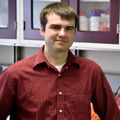Bacteria that Eat Electricity: Understanding Biocathodes Using Culture Independent Techniques
-
Brian Eddie, PhD
Research Biologist, Center for Bio/Molecular Science and Engineering, Naval Research Laboratory
Some bacteria can use an electrode as an electron donor for respiration, generating an electrical current in the process. We are trying to understand a bacterial community that uses electricity as an energy source to fix CO2 to make biomass. However, we are not able to grow some of the key organisms in pure cultures, so we need to use culture independent approaches. Metagenomics revealed 16 genome bins that were over 85% complete, each representing a different species. One of these species is a previously uncharacterized member of the Gammaproteobacteria that we described as “Candidatus Tenderia electrophaga.” At the genomic level, “Tenderia” has several genes also found in iron oxidizing bacteria that may allow it to make the proteins needed to transport electrons from the electrode into the cell. It can then use them to generate the ATP and reducing equivalents necessary for CO2 fixation. We then used metatranscriptomics and metabolic inhibitors to ground truth the model developed from the “Tenderia” genome sequence. One of our lab’s goals is to develop synthetic biology systems that will help meet the needs of the US Navy. We are in the process of developing isolates from this community as chassis organisms that will be more robust in the environment that the typical lab strains used for most genetic engineering.
Learning Objectives:
1. Identify the ways culture independent methods are used to study difficult to culture microbes
2. Understand concept of extracellular electron transport (EET)
3. Describe the importance of reverse electron transport to some lithoautotrophic organisms
Bacteria that Eat Electricity: Understanding Biocathodes Using Culture Independent Techniques
Please update your information
Certificate of Participation
DOWNLOAD CERTIFICATE






